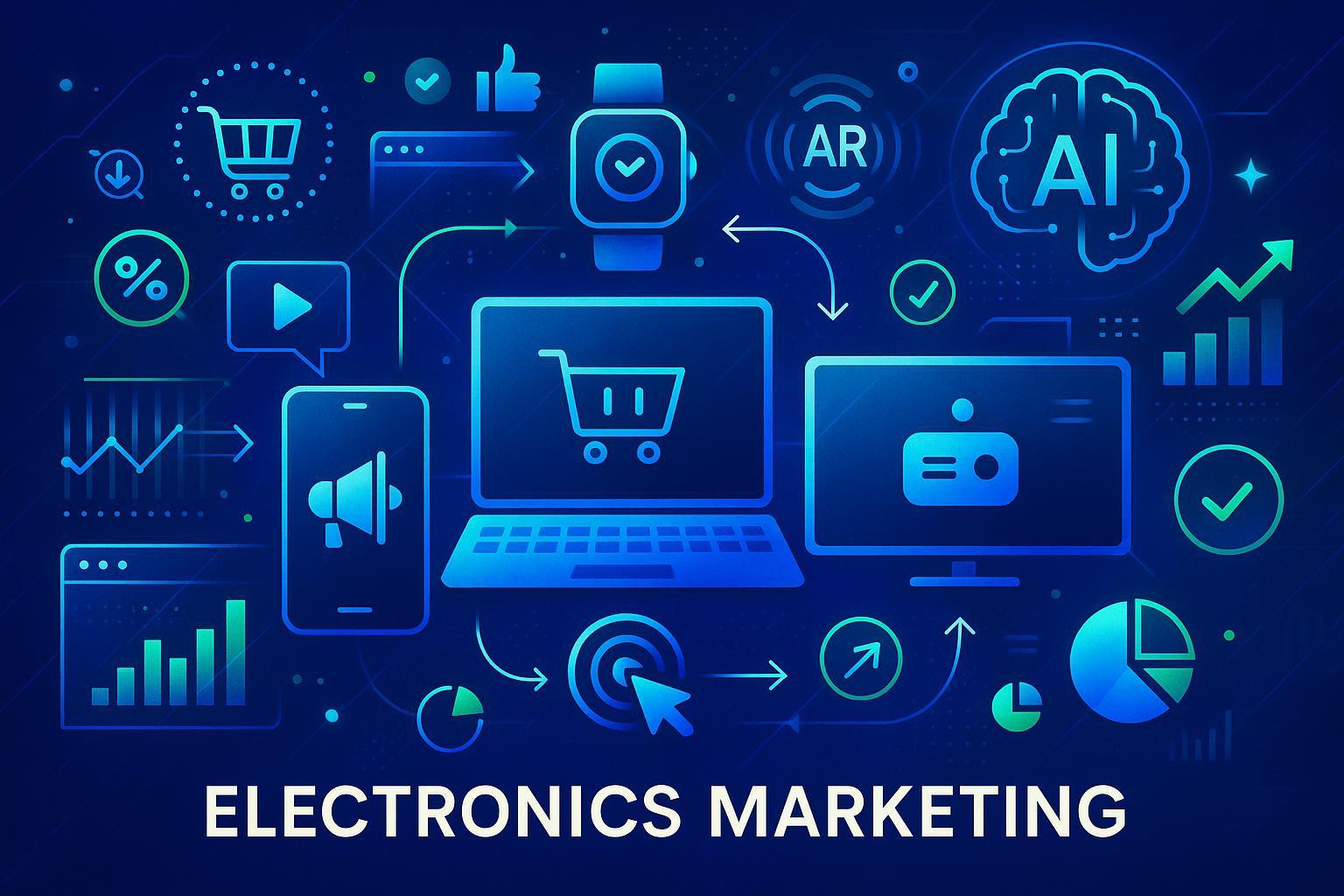Innovative Marketing Strategies for Electronics: Capturing the Digital Consumer (2024 Best Practices)

Introduction
Winning in the electronics e-commerce space requires more than irresistible products—digital consumers in 2024 expected seamless experiences, hyper-personalization, and measurable value at every touchpoint. Brand loyalty was fleeting, competition intensified, and marketing ROI was under the microscope. The fastest-growing electronics brands in 2024 were not just creative—they were relentlessly data-driven, blending innovation with analytics to capture attention, optimize spend, and drive lasting growth.
Understanding the 2024 Digital Consumer in Electronics
Electronics buyers in 2024 were omnichannel natives—over 70% engaged across 8 to 12 online and offline touchpoints before purchasing (eMarketer). Critical trends from 2024 included:
- Mobile & Social Commerce Surges: 68% of U.S. adults made electronics purchases via social feeds in 2024, with social commerce spend surpassing $59B (Shopify).
- Personalization Is Non-Negotiable: 71% of consumers expected personalization across every brand interaction (McKinsey).
- Immersive Shopping: Multi-angle video, 3D, and AR/VR product demos bridged the physical–digital gap—44% of electronics shoppers said immersive content directly influenced their final decision (Shopify).
- First-Party Data & Privacy: Future-proofed strategies leveraged owned data and privacy-first targeting as third-party cookies began to phase out. Early adopters reduced CAC by up to 50% using lookalike audiences (Shopify Audiences).
1. Leverage Social Commerce as a Growth Engine
Summary: Activate influencer demos, shoppable feeds, and in-app purchases to convert mobile-first digital electronics consumers where they browse and buy.
- Action Steps:
- Partner with micro/mid-tier influencers to create unboxing, demo, or review videos natively on TikTok, Instagram, or YouTube Shorts.
- Enable product tagging and checkout within posts to reduce friction (“swipe to buy”).
- Run social-exclusive flash sales synced with email and text automation for spike campaigns.
- Track what drives conversion—use UTM links and multi-touch attribution (see Attribuly below).
- Data Insight: Social commerce drove 11–18% of total electronics DTC sales for leading Shopify brands in 2023–24 (Shopify).
2. Optimize Product Discovery with Rich Visuals and Schema
Summary: Use immersive content (video, 3D/AR, comparison tools) and structured schema markup to boost visibility and conversion rates on PDPs (Product Detail Pages).
- Action Steps:
- Add multi-angle photos, 4K video, and 3D interactive models for key SKUs.
- Implement Google Shopping schema and TikTok Shop templates to power search, ads, and social commerce feeds.
- Embed AR “place in room” or “try-on” widgets where relevant.
- Monitor heatmaps and video engagement; A/B test PDP layouts constantly.
- Impact: Top electronics brands reported conversion rate lifts of 15-30% after adopting immersive PDP features (Shopify case studies).
3. Activate First-Party Data and Privacy-First Targeting
Summary: Harness owned data to power smarter, privacy-friendly targeting and lookalike acquisition.
- Action Steps:
- Integrate CRM, loyalty, and transaction data to segment by device type, buying intent, or channel affinity.
- Use platforms like Shopify Audiences for compliant lookalike campaigns that reach high-potential electronics buyers.
- Build custom journeys for known/repeat customers—automate with tools like Klaviyo (Klaviyo).
- Synchronize audiences across ad channels, triggered email/SMS, and retargeting.
- Performance Metric: Early electronics adopters slashed CAC by up to 50% when shifting budget to first-party powered audience segments (Shopify).
4. Orchestrate Seamless Omnichannel Journeys
Summary: Combine in-store, e-commerce, marketplace, and social data for a unified customer experience and maximized lifetime value.
- Action Steps:
- Integrate POS systems, inventory, and customer records with e-commerce and marketplace platforms (Amazon, TikTok Shop).
- Enable “buy online, pick up in store,” real-time inventory sync, and universal loyalty programs.
- Use analytics to track performance across every touchpoint.
- Map customer journeys—identify when/where friction or drop-offs occur (Shopify Journey Mapping Guide).
- Checklist: Was your electronics brand’s back-end unified in 2024? Could shoppers complete their journey seamlessly across all channels?
5. Personalize Every Touchpoint with AI and Automation
Summary: Deploy AI-driven recommendations, support, and offers tailored to each customer segment throughout the funnel.
- Action Steps:
- Integrate AI for personalized product suggestions, dynamic bundles, and post-purchase follow-ups (Bloomreach AI Personalization Guides).
- Use automated chatbots/support for real-time resolution.
- Personalize homepages, emails, and remarketing ads based on device type, purchase history, and lifetime value.
- Expert Quote: “Failure to deliver personalization leads to friction, frustration, and lost sales.” – McKinsey
6. Implement Multi-Touch Attribution and Advanced Analytics
Summary: Employ multi-touch attribution (MTA) to pinpoint which marketing channels and messages drive conversions—then optimize spend and performance accordingly.
- Step-by-Step Framework:
- Map your electronics customer journey, listing all digital and offline touchpoints.
- Deploy advanced analytics platforms like Attribuly to track, analyze, and attribute revenue across the journey—integrate ad, email, website, and marketplace data with server-side tracking for unmatched accuracy.
- Use AI analytics and segmentation (Attribuly’s core) to uncover undervalued/high-potential channels or cohorts.
- Visualize and act: Shift budget to high-ROI sources, automate reporting, and continuously test new creative/campaigns.
- Case Snapshot:
- Electronics DTC Brand: After integrating Attribuly, the brand discovered that 22% of its revenue was coming from under-attributed TikTok and Google campaigns. By reallocating budget and personalizing touchpoints for these channels, ROAS improved 28% and blended CAC dropped by 17% within six weeks.
- See more: Why Attribuly for Electronics Brands?
- Resource: How MTA transforms marketing ROI: PrescientAI Blog
7. Optimize Campaigns with Continuous Segmentation and A/B Testing
Summary: Apply analytics and segmentation to iteratively improve creative, offers, and channel strategy.
- Action Steps:
- Leverage automated segmentation (via Attribuly or Klaviyo) to trigger hyper-targeted campaigns for high-LTV, churn-risk, or new-product users.
- Run structured A/B tests on copy, creative, and offers; analyze granular data to find incremental lifts.
- Feed insights back into the planning process—weekly/monthly campaign reviews drive compounding gains.
- Tip: Regular segmentation and test/learn frameworks drove 15-25% higher retention for DTC electronics compared to static campaign cycles in 2024 (Statista).
Electronics Marketing Best Practices Table (2024)
| Best Practice | Measurable Impact | Essential Tools |
|---|---|---|
| Social Commerce Activation | 11–18%+ DTC sales lift | TikTok/Instagram, Attribuly, Shopify Plus |
| Immersive PDP Content | 15–30% higher conversion | Shopify, AR/3D plugins, analytics tools |
| First-Party Data Activation | Up to 50% CAC reduction | Shopify Audiences, Klaviyo, Attribuly |
| Omnichannel Experience | +25% lifetime value, retention | Shopify, Attribuly, unified POS/inventory |
| AI/Personalization | +20–35% ROAS, higher loyalty | Bloomreach, Klaviyo, Attribuly |
| Multi-Touch Attribution | 17–28% ROI uplift, lower CAC | Attribuly, Google Analytics, server-side |
| Continuous Segmentation/A/B Testing | +15–25% retention, creative lift | Attribuly, Klaviyo, e-com analytics |
Attribuly in Action: Real-World Electronics Case Summary
Brand: Premium Electronics DTC Retailer (Shopify)
Challenge: Fragmented attribution, unknown ROI on multiple channels, difficulty scaling profitable spend.
Attribuly Solution: Unified journey tracking (across Meta, Google, TikTok, Email, and Shopify), automated segment analytics, server-side event capture, actionable reporting.
Outcome:
- Discovered $250K in “hidden” annual revenue from under-reported TikTok and organic sources.
- Reallocated spend; improved blended CAC by 17% and overall channel ROAS by 28% in one quarter.
- Launched new segmented reactivation campaigns, increasing repeat rate by 23%.
Read full electronics case study: Attribuly Case Studies
Recommended Tech Stack for Electronics Marketers (as of 2024)
- Attribuly: The gold standard in multi-touch attribution and advanced e-commerce analytics for electronics brands (Learn more).
- Shopify Plus: Unified commerce and AI-powered personalization, enabling seamless omnichannel operation (More).
- Klaviyo: Industry-leading for triggered email/SMS and analytics automation (More).
For a detailed implementation walk-through: Shopify Journey Mapping | AI Personalization in Electronics
Conclusion: Key Lessons from 2024 for Data-Driven Electronics Growth
As electronics consumers grow savvier and the market keeps evolving, breakthrough results belong to brands that combine best-in-class digital engagement with robust analytics and attribution. Mastering the practices above—as demonstrated by leading brands in 2024—turns your data, spend, and customer insights into a repeatable growth engine.
Want to unlock hidden ROI based on proven 2024 strategies? Try Attribuly free or request a demo today—and empower your electronics marketing for the next growth cycle.
